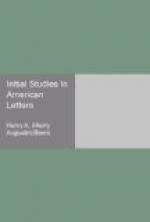In 1846, accordingly, the Biglow Papers began to appear in the Boston Courier, and were collected and published in book form in 1848. These were a series of rhymed satires upon the government and the war party, written in the Yankee dialect, and supposed to be the work of Hosea Biglow, a home-spun genius in a down-east country town, whose letters to the editor were indorsed and accompanied by the comments of the Rev. Homer Wilbur, A.M., pastor of the First Church in Jaalam, and (prospective) member of many learned societies. The first paper was a derisive address to a recruiting sergeant, with a denunciation of the “nigger-drivin’ States” and the “Northern dough-faces;” a plain hint that the North would do better to secede than to continue doing dirty work for the South; and an expression of those universal peace doctrines which were then in the air, and to which Longfellow gave serious utterance in his Occultation of Orion.
“Ez for war, I call it murder—
There you hev it plain an’
flat;
I don’t want to go no furder
Than my Testyment for that;
God hez said so plump an’ fairly,
It’s as long as it is
broad,
An’ you’ve gut to git up airly
Ef you want to take in God.”
The second number was a versified paraphrase of a letter received from Mr. Birdofredom Sawin, “a yung feller of our town that was cussed fool enuff to goe atrottin inter Miss Chiff arter a dram and fife,” and who finds when he gets to Mexico that
“This kind o’ sogerin’ aint a mite like our October trainin’.”
Of the subsequent papers the best was, perhaps, What Mr. Robinson Thinks, an election ballad, which caused universal laughter, and was on every body’s tongue.




